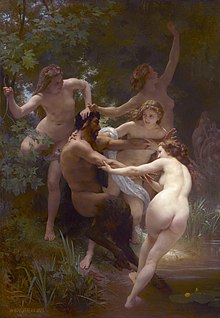Immersion
Your inner
effulgence radiated through your opaque costume
Breaking the
bounds of the spectrum
The ice of our
reserve melted
Into the embracing
waves
The water gods and
goddesses bade us undress
Our falling
garments answering ripples and eddies
Our costumes
coming off poured and distilled a rainbow
Into the purest
hue
Our love melted us
into the purest nectar

Nymphes et un satyre (Nymphs and Satyr) -- William-Adolphe Bouguereau
A satyros was one of Dionysos' male companions with goat-like features and a permanent erection. Early artistic representations had horse-like legs, but by the 6th century BCE they were generally shown with human legs. Lovers of wine and women, they played pipes (auloi), flutes, cymbals, castanets, and bagpipes, and caroused with Dionysos' female followers, the maenads or bacchants. Hesiodos called them brothers of the mountain nymphs and the nine Kuretes, the armed and crested dancers who worshipped the Phrygian goddess Cybele with drumming and dancing, who, according to pseudo-Apollodorus were the the offspring of Apollo, the god of music, poetry, truth, prophecy, the plagues, healing, the sun, and light, and Thalia, the Muse who presided over comedy and idyllic poetry. Apollo was the son of Zeus and Leto, and Thalia was the the daughter of Zeus and Mnemosyne, the eighth-born of the nine Muses.
ReplyDeleteA nymphe was a beautiful, young, nubile maiden who loved t dance and sing; she was usually associated with a particular location or landform, especially a spring or stream. Although she could not die of old age nor illness, she was not necessarily immortal Oftern she was part of the fivine retinue of the chaste huntress Artemis (the twin sister of Apollo), Dionysos, Hermes, or Pan. She tended to be aloof from people but would sometimes mate with humans of either sex and were completely beyond male control, though her name also meant "bride," "veiled," and "rosebud." Sometimes humans would encounter a nymphe dancing or bathing during the noon heat or in the middle of the night, or she might appear in a whirlwind, but such encounters could cause muteness, madness, besotted infatuation, or a stroke to the human.
Although the Greeks did not always distinguish between them, Homer usually identified nectar as the drink of the gods and ambrosia as their food, while Alcman wrote that nectar was the food, and Sappho and Anaxandrides wrote ambrosia was the drink; whoever consumed it obtained longevity or immortality. Both were fragrant and could be used as perfume. Ambrosia was sometimes depicted in art as being distributed by a nymphe with the same name; labeled with that name; In the story of Lycurgus, an opponent of Dionysos, violence against Ambrosia turned her into a grapevine; it was also claimed to have been taken to the gods in Olympus by doves.
ReplyDelete